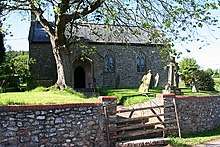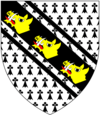Culm Davy
Culm Davy is a historic manor within the parish of Hemyock in Devon.[2]

History
The estate of Cumbe is listed in the Domesday Book of 1086 as one the 27 Devonshire holdings of Theobald FitzBerner,[3] an Anglo-Norman warrior and magnate, one of the tenants-in-chief in Devon of King William the Conqueror. His tenant was Oliver,[4] who held three of FitzBerner's Devonshire manors, the others being Widworthy and Marwood.[5]
The manor subsequently became a possession of the feudal barony of Great Torrington. The 13th century Book of Fees records that the manor was held from the feudal barony by David de Wydworth (fl. tempore King Henry III (1216-1272)[6])(alias de Widworthy),[2] and was called after him either "Culm Davy" or "Culm Wydeworth".[2] He lived chiefly in Wales and was a younger son of Sir William de Widworthy of Widworthy,[6] in Colyton hundred, also a Domesday Book possession of Theobald FitzBerner tenanted by Oliver.[7]
Following the de Widworthy tenure, the manor was held by Sir John Wogan (during the reign of King Edward I [1272-1307]), then by Roger Corbet (during the reign of King Edward III [1327-1377]).[6]

From the reign of King Edward III (1327-1377) and following the Corbet tenure, the manor was held by John Bourman[6] (whose family name was later spelled "Bowerman"). It was the seat of his descendants for seven generations until the time of Pole (d.1635).[9] The Bowerman family of Hemyock was descended from Nicholas Bourman of Brooke in the Isle of Wight, by his wife Elizabeth Russell, a sister of John Russell, 1st Earl of Bedford (c.1485-1555).[9] Two of his grandsons were Rev. John Bourman, a priest and confessor to the nuns of Canonsleigh Abbey, near Hemyock; and Rev. William Bourman, a priest and sub-dean and canon of Wells Cathedral in Somerset.[9]
The Kerslake family acquired Culm Davy in about 1700 and then a Mr. Marsh of Wellington acquired it from the Kerslake family.[10] A series of deeds relating to Culm Davy dating from 1612 to 1778 are held at the Somerset Heritage Centre.[11]
In the early 19th century Culm Davy was the property of Mr. Henry Pook.[10]
Manor house
Part of the mediaeval manor house of the Bowerman family survives within the structure of the present Culm Davy farmhouse, including the roof timbers.[12] Nearby was the small 15th century chapel of ease, which survives today, although it was heavily restored in 1860.[1] It contains an unusual mural monument "of the utmost primitiveness" for such a late date, to Anne Garvis (d.1705) of Ash Culm, comprising a classical entablature below an effigy lying on its side.[13]
References
- Pevsner, p.479
- Thorn, Part 2, 36:18
- Thorn, Part 1, 36:7; Part 2, 36:7
- Thorn, Part 1, 36:18
- Thorn, 36:16; Part 2, Index of Names, "Oliver"
- Pole, Sir William (d.1635), Collections Towards a Description of the County of Devon, Sir John-William de la Pole (ed.), London, 1791, p.202
- Thorn, Part 2, 36:26
- Blazoned as Ermine, on a bend cotised sable three boar's heads couped or in Vivian, p.108
- Vivian, pp.108-9
- Lysons, Daniel & Lysons, Samuel, Magna Britannia, Vol.6, Devonshire, London, 1822. p.268
- "Dodman and Pulman, solicitors, records - Box 11: miscellaneous". The National Archives.
- Pevsner, Nikolaus & Cherry, Bridget, The Buildings of England: Devon, London, 2004, p.479
- Listed building text ; and see image
Sources
- Thorn, Caroline & Frank, (eds.) Domesday Book Vol. 9: Devon, Parts 1 & 2, Phillimore Press, Chichester, 1985.
- Vivian, Lt.Col. J.L., (Ed.) The Visitations of the County of Devon: Comprising the Heralds' Visitations of 1531, 1564 & 1620. Exeter, 1895.